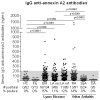Annexin A2 is a target of autoimmune T and B cell responses associated with synovial fibroblast proliferation in patients with antibiotic-refractory Lyme arthritis
- PMID: 26187145
- PMCID: PMC4582008
- DOI: 10.1016/j.clim.2015.07.005
Annexin A2 is a target of autoimmune T and B cell responses associated with synovial fibroblast proliferation in patients with antibiotic-refractory Lyme arthritis
Abstract
In this study, autoantibody responses to annexin A2 were found in 11-15% of 278 patients with Lyme disease, including in those with erythema migrans (EM), an early sign of the illness, and in those with antibiotic-responsive or antibiotic-refractory Lyme arthritis (LA), a late disease manifestation. In contrast, robust T cell reactivity to annexin A2 peptides was found only in patients with responsive or refractory LA. In LA patients, annexin A2 protein levels, which were higher in the refractory group, correlated with annexin A2 antibody levels in sera and synovial fluid. In addition, in patients with antibiotic-refractory LA who had anti-annexin A2 antibodies, synovial tissue had intense staining for annexin A2 protein, greater synovial fibroblast proliferation and more tissue fibrosis. Thus, a subset of LA patients had T and B cell responses to annexin A2, and in the refractory group, annexin A2 autoantibodies were associated with specific pathologic findings.
Keywords: Annexin A2; Autoantigen; Borrelia burgdorferi; Lyme arthritis; Lyme disease.
Copyright © 2015 Elsevier Inc. All rights reserved.
Figures






Similar articles
-
Matrix metalloproteinase-10 is a target of T and B cell responses that correlate with synovial pathology in patients with antibiotic-refractory Lyme arthritis.J Autoimmun. 2016 May;69:24-37. doi: 10.1016/j.jaut.2016.02.005. Epub 2016 Feb 26. J Autoimmun. 2016. PMID: 26922382 Free PMC article.
-
Correlation of Lyme Disease-Associated IgG4 Autoantibodies With Synovial Pathology in Antibiotic-Refractory Lyme Arthritis.Arthritis Rheumatol. 2018 Nov;70(11):1835-1846. doi: 10.1002/art.40566. Epub 2018 Sep 24. Arthritis Rheumatol. 2018. PMID: 29790305 Free PMC article.
-
T-Helper 17 Cell Cytokine Responses in Lyme Disease Correlate With Borrelia burgdorferi Antibodies During Early Infection and With Autoantibodies Late in the Illness in Patients With Antibiotic-Refractory Lyme Arthritis.Clin Infect Dis. 2017 Apr 1;64(7):930-938. doi: 10.1093/cid/cix002. Clin Infect Dis. 2017. PMID: 28077518 Free PMC article.
-
Lyme arthritis and post-Lyme disease syndrome.Curr Opin Rheumatol. 2002 Jul;14(4):383-7. doi: 10.1097/00002281-200207000-00008. Curr Opin Rheumatol. 2002. PMID: 12118171 Review.
-
[Early diagnosis of Lyme borreliosis].MMW Fortschr Med. 2006 Jun 22;148(25):32, 34, 36. MMW Fortschr Med. 2006. PMID: 16859158 Review. German.
Cited by
-
Identification of Major Histocompatibility Complex Class II Epitopes From Lyme Autoantigen Apolipoprotein B-100 and Borrelia burgdorferi Mcp4 in Murine Lyme Arthritis.J Infect Dis. 2024 Aug 14;230(Supplement_1):S27-S39. doi: 10.1093/infdis/jiae324. J Infect Dis. 2024. PMID: 39140726
-
Lyme Arthritis: A 50-Year Journey.J Infect Dis. 2024 Aug 14;230(Supplement_1):S1-S10. doi: 10.1093/infdis/jiae126. J Infect Dis. 2024. PMID: 39140724 Review.
-
Variants in the Late Cornified Envelope Gene Locus Are Associated With Elevated T-helper 17 Responses in Patients With Postinfectious Lyme Arthritis.J Infect Dis. 2024 Aug 14;230(Supplement_1):S40-S50. doi: 10.1093/infdis/jiae164. J Infect Dis. 2024. PMID: 39140723
-
HLA-DR-Expressing Fibroblast-Like Synoviocytes Are Inducible Antigen Presenting Cells That Present Autoantigens in Lyme Arthritis.ACR Open Rheumatol. 2024 Oct;6(10):678-689. doi: 10.1002/acr2.11710. Epub 2024 Jul 27. ACR Open Rheumatol. 2024. PMID: 39073021 Free PMC article.
-
Synthesis of a Borrelia burgdorferi-Derived Muropeptide Standard Fragment Library.Molecules. 2024 Jul 12;29(14):3297. doi: 10.3390/molecules29143297. Molecules. 2024. PMID: 39064876 Free PMC article.
References
Publication types
MeSH terms
Substances
Grants and funding
LinkOut - more resources
Full Text Sources
Other Literature Sources
Medical
Miscellaneous

